- About Us
- Columns
- Letters
- Cartoons
- The Udder Limits
- Archives
- Ezy Reading Archive
- 2024 Cud Archives
- 2023 Cud Archives
- 2022 Cud Archives
- 2021 Cud Archives
- 2020 Cud Archives
- 2015-2019
- 2010-2014
- 2004-2009
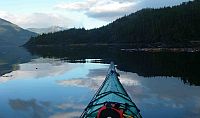 |
The Cud In The Wild — Another Fin(n) In The Water: Kayaking The Inside Passage |
Buoyed by his successful role in Capt. Cook's voyages, George Vancouver was charged with captaining his own ship "The Discovery" to chart the west coast of North America in 1792. His 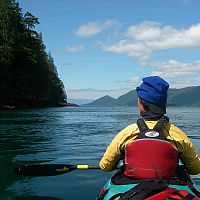 meticulous efforts revealed a passage between the modern day cities of Seattle, Washington and Juneau, Alaska, with Canada's entire west coast in between. A century later when prospectors rushed 'north to Alaska' for the Klondike Goldrushes, this protected route became known as the "Inside Passage" - a maze of islands and channels affording almost unbroken protection from the open waters of the Pacific Ocean (and hence distinct from the Outside Passage).
meticulous efforts revealed a passage between the modern day cities of Seattle, Washington and Juneau, Alaska, with Canada's entire west coast in between. A century later when prospectors rushed 'north to Alaska' for the Klondike Goldrushes, this protected route became known as the "Inside Passage" - a maze of islands and channels affording almost unbroken protection from the open waters of the Pacific Ocean (and hence distinct from the Outside Passage).
To this day it remains a complicated 2000 km waterway that is the passage for cruise ships, salmon boats, log booms, pleasure boaters and the odd sea kayaker. So buoyed by my own successful role for 12 months in the city which George Vancouver so graciously offered his name, this 'odd sea kayaker' set off from the shores of Jericho Beach in English Bay (Vancouver's Sydney Harbour) to paddle roughly a quarter of this famous passage. Having bought a brand new double sea kayak (a 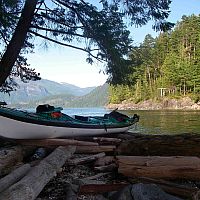 Seaward Passat G3 for the boaties), I set out on a typically grey and wet Vancouver morning in early June, having filled the bulkheads with camping supplies, and filled the bow seat cockpit with Lailey - my attractive Canadian paddling companion (...the continued attempts to be Alby Mangels...).
Seaward Passat G3 for the boaties), I set out on a typically grey and wet Vancouver morning in early June, having filled the bulkheads with camping supplies, and filled the bow seat cockpit with Lailey - my attractive Canadian paddling companion (...the continued attempts to be Alby Mangels...).
Over the next three weeks we would paddle 480 kms to Port Hardy, on the northern tip of Vancouver Island, passing northwest along British Columbia's Sunshine Coast, into the majestic Desolation Sound (named by Vancouver in one of his darker moments, and a portion where we were accompanied by a far cheerier Pommy boater), through the tidal rapids of the Discovery Islands and then into the schizophrenic waters of Johnstone and Queen Charlotte Straits. And while we kept watchful eyes on tidal charts, marine weather forecasts and possible campsites, our persistent strokes were made under the similarly watchful eyes of seals, sea lions, dolphins, minks, bald eagles and other less notable sea and bird life. We may also have been observed by orcas and bears, but we didn't manage to ever catch their gaze - for better or for worse.
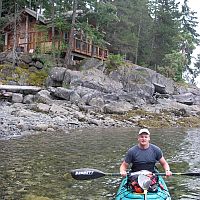 Even in these protected waters the paddling can be challenging. Unseasonably for the twenty days in June that we were on the water, there was a small craft warning for the Strait of Georgia (which covered the first third of our journey and I suspect included our 23 foot kayak). There are constant warnings about the Yaculta and Dent Rapids in the Discovery Islands - rapids not in the rocky downriver sense, but raging whitewater flows of over 10 knots caused by large volumes of water being funneled through narrow channels (only passable by paddling power when timed exactly with slack tides).
Even in these protected waters the paddling can be challenging. Unseasonably for the twenty days in June that we were on the water, there was a small craft warning for the Strait of Georgia (which covered the first third of our journey and I suspect included our 23 foot kayak). There are constant warnings about the Yaculta and Dent Rapids in the Discovery Islands - rapids not in the rocky downriver sense, but raging whitewater flows of over 10 knots caused by large volumes of water being funneled through narrow channels (only passable by paddling power when timed exactly with slack tides).
And of course the other great fluid challenge in these rugged parts - surviving the hard drinking life of loggers, salmon fishermen and unfailingly supportive locals. The journey nearly stalled on the first night after paddling from Vancouver to Gibson's Landing (where "Beachcombers" was filmed) when I drank far too many celebratory beers with an experienced sailor and drinker, considering our adventure was only a day old.
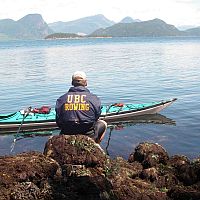 But for the trials of three weeks in a boat, we would have happily kept going north along the British Columbian coast and Alaskan Panhandle, inspired by the snowcapped peaks, forests of conifer and life on the shore that is only captured by the 'stately' 4-5 knot passing of a sea kayak. It took Vancouver several years to chart the entire coastline, heading to Hawaii for the harsh winter months, to then return each summer and continue where he'd left off. And while the kayak is being sold to recover some of the costs of the trip (most significantly its original purchase), it may need to be tracked down again one northern summer when the rest of its course north through the Inside Passage beckons again.
But for the trials of three weeks in a boat, we would have happily kept going north along the British Columbian coast and Alaskan Panhandle, inspired by the snowcapped peaks, forests of conifer and life on the shore that is only captured by the 'stately' 4-5 knot passing of a sea kayak. It took Vancouver several years to chart the entire coastline, heading to Hawaii for the harsh winter months, to then return each summer and continue where he'd left off. And while the kayak is being sold to recover some of the costs of the trip (most significantly its original purchase), it may need to be tracked down again one northern summer when the rest of its course north through the Inside Passage beckons again.
